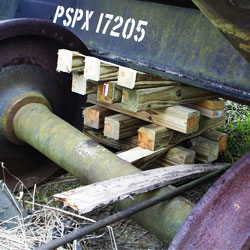Technical Rescue Incident Preparedness: Hazard Identification and Risk Assessment
 Whether you’re a relatively new or a well-established Technical Search and Rescue (TSAR) organization, following an established Hazard Identification and Risk Assessment process is a great way to ensure you’re prepared for the “Big One."
Whether you’re a relatively new or a well-established Technical Search and Rescue (TSAR) organization, following an established Hazard Identification and Risk Assessment process is a great way to ensure you’re prepared for the “Big One."
The “Big One” is that incident where you’re called upon to deliver on the organizational investment of having a TSAR capability. A great deal of organizational time, money, and effort is invested in developing, maintaining, and deploying a Rescue Team. Plant Administrators, Fire Chiefs, and elected officials (private board members or public officials) want to see a return on that investment when their rescue service is called into action to save a life.
The purpose of this article is to assist the Rescue Team Leader (RTL) and aspiring RTL (because we should always be developing our replacement) in establishing a Rescue Team, developing a new TSAR capability, or ensuring an established Rescue Team is adequately prepared for the “Big One."
 Firstly, if there is a potential for a TSAR incident to occur within your jurisdiction, NFPA 1670 requires the authority having jurisdiction (AHJ) to address a number of “General Requirements” found in Chapter 4. The review and completion of these requirements are usually a function of the Rescue Team Leader along with key management personnel who authorize, budget, schedule, and equip the Rescue Team.
Firstly, if there is a potential for a TSAR incident to occur within your jurisdiction, NFPA 1670 requires the authority having jurisdiction (AHJ) to address a number of “General Requirements” found in Chapter 4. The review and completion of these requirements are usually a function of the Rescue Team Leader along with key management personnel who authorize, budget, schedule, and equip the Rescue Team.
The format of Chapter 4 is useful for all Rescue Teams, whether newly formed or long established. It is an excellent tool for ensuring some of the foundational aspects of preparedness and organizational structure are (or have been) properly established. Most “senior rescuers” (not those on Medicare but those that have the respect, time, and experience that makes them leaders in technical rescue) will tell you that the TSAR incident potential, including their hazards and risks, change as industrial processes are updated, installed, or eliminated.
Key to all emergency response success is planning and preparation. However, incident preparation should be driven by the types of emergency incidents that have a potential for occurring within a given jurisdiction. This is the starting point for determining rescue capabilities, SOP/SOG’s, staffing, training, and equipment.

The Hazard Identification and Risk Assessment is one method for assessing incident potential. NFPA defines:
• Hazard Identification - The process of identifying situations or conditions that have the potential to cause injury to people, damage to property, or damage to the environment.
• Risk Assessment - An assessment of the likelihood, vulnerability, and magnitude of incidents that could result from the exposure to hazards.
This process identifies the possibility of conducting TSAR operations within a jurisdiction by evaluating environmental, physical, social, and cultural factors that influence the scope, frequency and magnitude of a potential TSAR incident. It also addresses the impact the incident has on the AHJ to respond and conduct operations while minimizing threats to rescuers (NPFA 1670, 4.2.1 and 4.2.2). The standard lists a number of scientific methodologies in its annex but in the spirit of keeping it, we’ll approach this process using a Preliminary Checklist. (See Sample Checklist.)
Once completed, the checklist may have entries that require further analysis, identify a need to develop or expand a capability, or require entering into an agreement with an external resource.
 This checklist is for day-to-day incident responses under predictable jurisdictional response conditions and should not be used for disaster scenarios where large scale regional and federal resources will be required to mitigate the incident. These scenarios should be addressed through Emergency Response Plans.
This checklist is for day-to-day incident responses under predictable jurisdictional response conditions and should not be used for disaster scenarios where large scale regional and federal resources will be required to mitigate the incident. These scenarios should be addressed through Emergency Response Plans.
Most fire departments and other emergency response organizations want to maintain a response capability that match potential incidents in order to be operationally effective, provide for rescuer safety, and have positive incident outcomes.
A Hazard Identification and Risk Assessment is an excellent way to evaluate your organization’s preparedness level for technical rescue incidents based the potential for one to occur; it also aids in the development of specific capability.




